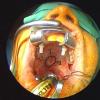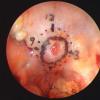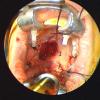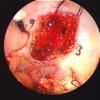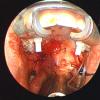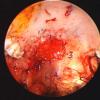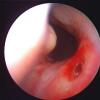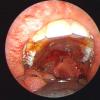Click on image above to enlarge; advance with cursor over border
see also: Buccal mucosa and Masticator space anatomy; Mucoepidermoid Carcinoma Histopathology; Salivary Gland Cases; Mucoepidermoid Carcinoma Radiographic Imaging
return to: Buccal Fat Flap Reconstruction of Palate Defects
Minor salivary gland cancer - low grade mucoepidermoid carcinoma of the palate
Edited Operative Note
Wide local excision of mucoepidermoid of the palate
Buccal fat flap reconstruction
Obturator placement, right nasal packing, nasal endoscopy
Patient is a 16-year-old white male with a history of slowly enlarging mass on his hard palate on the right side. This has been biopsied in clinic and found to be consistent with mucoepidermoid carcinoma, low-grade. He was referred to the operating room for third molar tooth extractions by the Oral Surgery Service as well as a wide local excision with reconstruction by Otolaryngology.
A Crowe-Davis retractor was placed into the oral cavity and the palate was inspected, demonstrating a 2.5 by 3 cm area of firmness on the right at the junction of the hard and soft palate consistent with the previously biopsied mucoepidermoid carcinoma. Photographic documentation was performed of the lesion as well as the planned resection. Using monopolar cautery, the lesion was excised en bloc down to the level of the palatal bone of the hard palate, and leaving a narrow band of fascia underlying the nasal mucosa. An area of the cancer appeared to be invading more superiorly into the nasal floor mucosa, and a frozen section was taken of this area resulting in an oronasal communication. Frozen sections were then taken circumferentially around the tumor and negative for any residual carcinoma. A bony margin (encompassed by soft tissue margins) was sent for permanent section.
At this point, all bleeding was stopped using bipolar cautery. The monopolar cautery was then used to incise along the patient's right buccal mucosa through buccinator posterio-inferior to Stenson's Duct. Using blunt dissection technique, the buccal fat pad was mobilized and rotated over the palate. It was tacked into place using interrupted 3-0 Vicryl sutures. Specifically, a flap of this buccal fat was tacked to cover the oronasal fistula that was formed during resection of the mucoepidermoid carcinoma. The deep muscle tissue on the posterior aspect of the resection was closed using interrupted 3-0 Vicryl stitches. A single 3-0 Vicryl stitch was placed to reapproximate the buccal incision that was used to harvest the buccal fat pad. The previously formed obturator was then placed into the patient's oral cavity and secured in place using two 2.0 mm KLS Martin screws. A Merocel pack was then placed into the patient's right nasal cavity after photographic documentation was performed of the oronasal fistula.
The patient tolerated the procedure well and there were no periprocedural complications. He was resuscitated from anesthesia and transferred to the Post-Anesthesia Care Unit with stable vital signs.
